Top Energy Efficiency Solutions for UAE & GCC Industrial and Commercial Facilities
For engineers, panel builders, and procurement teams in the demanding climate of the UAE and GCC, optimising energy consumption is a critical business strategy. Selecting the right electrical components UAE suppliers offer is paramount to reducing operational expenditure and meeting stringent regional standards. This guide details powerful energy efficiency solutions tailored for local conditions, focusing on practical insights to support your decision-making.
1. High-Efficiency LED Lighting Technology
Upgrading to Light Emitting Diode (LED) technology is one of the most impactful energy efficiency solutions. Unlike legacy lighting, LEDs convert a higher percentage of electricity into light, not heat. This switch unlocks cascading benefits beyond lower electricity bills, making it a cornerstone energy management solution Dubai facilities should prioritize.
The low heat emission of LEDs is a crucial advantage in the GCC. Every watt saved on lighting is a watt your HVAC system doesn't have to cool, delivering a double dividend in energy savings.
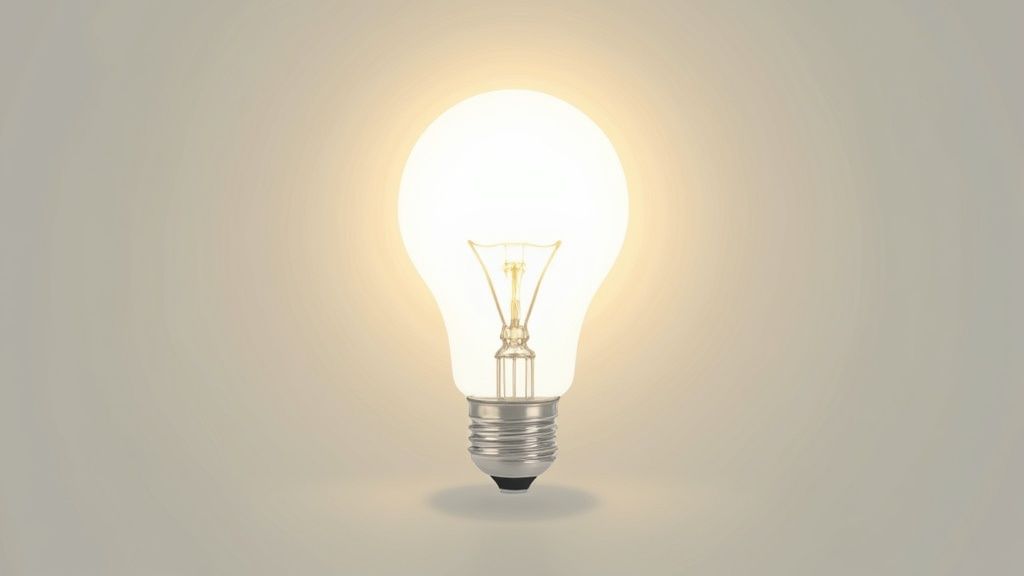
Why LEDs Are a Top Energy Efficiency Solution
Industrial applications in Jebel Ali Free Zone (JAFZA) have demonstrated that high-bay LEDs cut operational expenditure and drastically improve worker safety. Major malls across Dubai and Abu Dhabi report over 60% savings on lighting costs post-retrofit.
Key Benefit: LEDs consume up to 80% less energy and last up to 25 times longer than traditional incandescent bulbs, drastically reducing both energy consumption and maintenance costs.
Practical Implementation in the GCC
Successful implementation requires product selection tailored to the local environment.
- Verify IP Ratings: For dusty industrial sites or humid coastal areas, insist on a high Ingress Protection (IP) rating like IP65 or higher to ensure durability against dust and moisture, a key concern for electrical components UAE projects face.
- Select Correct Colour Temperature: For workshops and offices, a cool white light between 4000K and 5000K enhances visibility.
- Integrate Smart Controls: Maximise savings by pairing LEDs with motion sensors or networked lighting controls.
- Calculate True Payback: Factor in direct energy savings and the corresponding reduction in HVAC load for a complete financial picture.
GoSwitchgear offers a wide portfolio of industrial-grade LED solutions designed to withstand the operational demands of the region.
2. Smart Thermostats
Controlling your HVAC system is the next frontier for significant energy savings. Smart thermostats intelligently manage heating and cooling by learning occupancy patterns and reacting to weather forecasts, representing a major step up from basic programmable models.
In the GCC, where air conditioning can account for over 70% of a building's electricity consumption, a smart thermostat is a powerful solution. By preventing unnecessary cooling of empty offices, these devices deliver immediate and substantial reductions in operational expenditure.
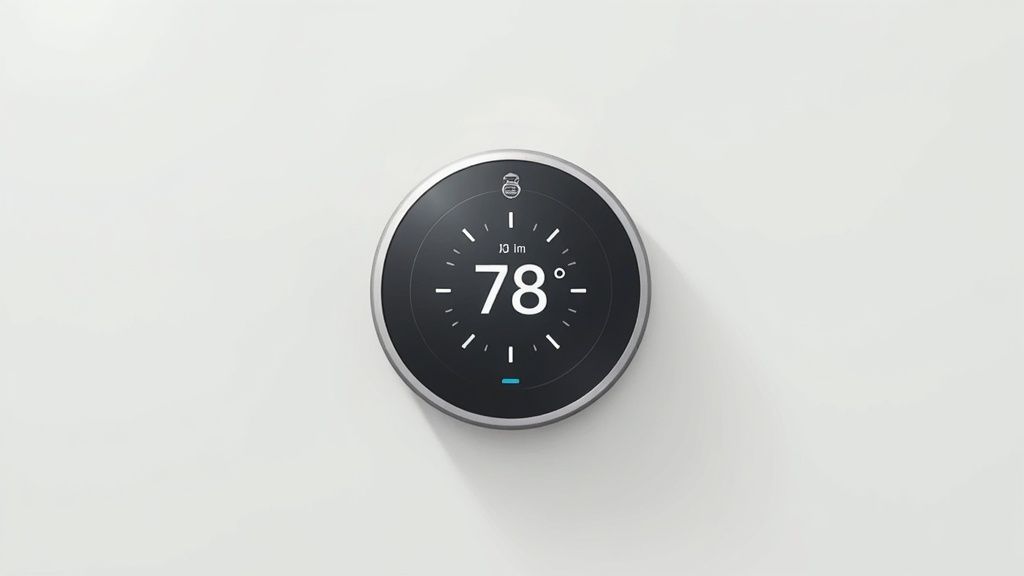
Why Smart Thermostats are a Core Energy Solution
The intelligence of a smart thermostat lies in its ability to adapt. For facilities in Dubai or industrial offices in Saudi Arabia, they automatically set back temperatures after hours and resume normal operations before staff arrive. This automation eliminates human error. Once installed, it's crucial to understand how to effectively use and program these smart devices; there are many easy tips to program thermostats for energy savings that can make a major difference.
Key Benefit: Smart thermostats can reduce HVAC energy use by 10-15% on average by optimising temperature settings based on real-time data and occupancy, delivering a rapid return on investment.
Practical Implementation in the GCC
Deploying smart thermostats effectively requires strategic placement and setup.
- Ensure HVAC Compatibility: Before purchasing, verify the smart thermostat model is compatible with your specific HVAC system.
- Strategic Installation: Install the thermostat in a central area away from direct sunlight or air vents to ensure an accurate ambient temperature reading.
- Utilise Geofencing: Use the geofencing feature to automatically switch to an energy-saving "away" mode when the last person leaves the area.
- Check for Rebates: Check with local utility providers like DEWA or SEWA, as they may offer incentives for installing certified energy-saving devices.
3. Building Energy Management Systems (BEMS)
A Building Energy Management System (BEMS) is a sophisticated step towards holistic energy efficiency. These intelligent systems act as the central nervous system for a facility, monitoring and controlling critical equipment like HVAC, lighting, and power distribution.
For large-scale towers in Dubai or industrial complexes in Saudi Arabia, a BEMS provides unparalleled control. By collecting real-time data and automating responses, it moves beyond simple on/off functions to predictive control, essential for identifying inefficiencies. A well-implemented BEMS, featuring components like a quality SMPS power supply for control panels, can reduce overall consumption by 10-20%.
Why BEMS Is a Key Energy Efficiency Solution
The power of a BEMS lies in its data-driven oversight. In a climate like the GCC's, such systems can automatically adjust cooling setpoints based on occupancy from an energy meter GCC-wide network or dim lights in unused zones, delivering substantial operational expenditure reductions.
Key Benefit: A BEMS provides real-time monitoring and automated control over a building’s entire energy footprint, enabling intelligent optimisation that can lead to significant and sustained energy reductions.
Practical Implementation in the GCC
A successful BEMS deployment requires a strategic approach.
- Start with an Energy Audit: Conduct a thorough audit to identify the biggest energy consumers and key opportunities for optimisation.
- Prioritise Scalability: Choose a system that can accommodate future expansions, like EV charging stations.
- Ensure System Cybersecurity: As these systems are networked, implementing robust cybersecurity protocols is non-negotiable. To delve deeper, refer to this complete guide on Building Energy Management Systems.
- Invest in Staff Training: Proper training for your facility management team is crucial for leveraging the system's full capabilities.
GoSwitchgear’s comprehensive energy management solutions provide foundational components for a robust BEMS installation.
4. Variable Frequency Drives (VFDs)
Variable Frequency Drives (VFDs) are sophisticated controllers that optimise AC electric motor performance. They adjust motor speed and torque to match real-time load demand, a cornerstone technology for systems with variable loads like pumps and fans, where it can slash energy use by 20-50%.
In the GCC's demanding environments, motors often run at constant speeds regardless of need. Implementing VFDs eliminates this waste. By slowing a motor when full output isn't required, a VFD delivers exponential energy savings, as power consumption is proportional to the cube of motor speed.

Why VFDs Are a Top Energy Efficiency Solution
The impact of VFDs is well-documented. Their ability to deliver tangible operational cost reductions and enhanced process control makes them an essential component for industrial efficiency.
Key Benefit: VFDs can reduce a motor's energy consumption by up to 50% while also decreasing mechanical stress, which extends equipment lifespan and lowers maintenance costs.
Practical Implementation in the GCC
Effective VFD deployment requires a strategic approach.
- Conduct a Motor Load Analysis: VFDs are most effective on motors with significant periods of low-load operation.
- Properly Size the VFD: Ensure the VFD is correctly sized for the motor's horsepower, voltage, and duty cycle to prevent premature failure.
- Address Power Quality: Installing harmonic filters may be necessary to mitigate electrical disturbances and maintain compliance with utility standards like those from DEWA.
- Prioritise Staff Training: Train engineers on VFD operation, programming, and troubleshooting to maximise uptime.
GoSwitchgear stocks a comprehensive range of VFDs from leading brands, engineered to meet the specific demands of the GCC region.
5. High-Performance Insulation Materials
The building envelope is the first line of defence against the intense heat of the UAE and GCC. High-performance insulation provides superior thermal resistance (R-value), drastically reducing heat transfer and lessening the burden on HVAC systems.
Advanced insulation like aerogels and specialised foams offer exceptional thermal performance in a thin profile, making them powerful energy efficiency solutions for retrofits. Reducing heat gain is a fundamental step towards deep energy savings, occupant comfort, and compliance with local building codes. While this guide focuses on active systems, optimizing passive elements like skylights also contributes significantly. For more on this, see this comprehensive guide to skylight energy efficiency.
Why Advanced Insulation Is a Critical Solution
High-grade insulation has a proven impact. Passive House projects, relying on a super-insulated envelope, demonstrate up to a 90% reduction in cooling needs. Commercial retrofits using high-performance panels have cut building energy consumption by over 35%, showcasing the technology’s immense potential for the GCC.
Key Benefit: Superior thermal resistance minimises heat gain, directly cutting HVAC energy consumption by 30% or more and significantly improving the building's overall energy performance.
Practical Implementation in the GCC
Correct installation is paramount to realizing insulation's benefits.
- Address Thermal Bridges: Use thermal breaks and continuous insulation strategies to mitigate heat bypass through conductive materials like steel studs.
- Combine with Air Sealing: Air leakage can account for significant energy loss. Conduct a blower door test to identify and seal leaks in the building envelope.
- Ensure Proper Installation: Gaps, compression, and moisture severely degrade insulation performance. Ensure installation is performed by trained professionals according to IEC or local standards.
- Model for Optimisation: For new builds in Dubai or Abu Dhabi, use thermal modelling software to optimise insulation type and thickness for the best ROI.
6. Power Factor Correction Technology
Many industrial facilities draw "reactive power" for equipment like motors, which doesn't perform useful work but strains the electrical grid. Power Factor Correction (PFC) technology counteracts this, improving the Power Factor (PF) towards the ideal 1.0. This optimisation reduces energy losses and can eliminate costly utility penalties.
For industrial operations in the UAE and GCC, a poor power factor is a hidden cost. By installing PFC equipment, facilities unlock capacity, reduce heat losses in transformers and cables, and improve voltage stability, making it a critical investment for electrical infrastructure optimization.
Why Power Factor Correction is a Key Energy Efficiency Solution
Poor power factor forces your system to draw more current than necessary, leading to higher electricity bills. For example, a KSA manufacturing facility avoided a significant annual utility penalty by improving its power factor with an automated system.
Key Benefit: Correcting your power factor to 0.95 or higher can reduce demand charges from utilities, lower energy losses by up to 15%, and increase the capacity of your existing electrical system.
Practical Implementation in the GCC
Effective PFC implementation requires a strategic approach.
- Conduct a Power Quality Audit: Perform a professional audit to measure your existing power factor and identify sources of reactive power.
- Properly Size Equipment: PFC units (capacitor banks) must be sized according to your load's reactive power requirements.
- Consider Automatic PFC Relays: For facilities with variable loads, an Automatic Power Factor Correction (APFC) panel with switching relays is ideal, ensuring optimal correction at all times.
- Ensure System Protection: Install protection devices like detuned reactors, especially in networks with high harmonic distortion, to protect capacitors and sensitive equipment.
GoSwitchgear can help design and implement the right solution. To understand more, learn more about our Power Factor Correction solutions.
7. Energy Recovery Ventilation (ERV) Systems
Energy Recovery Ventilation (ERV) systems reduce HVAC energy consumption while maintaining superior indoor air quality. In the GCC's climate, ERVs introduce fresh, filtered outdoor air without the massive energy penalty of cooling it from scratch by using stale, conditioned exhaust air to pre-cool the incoming fresh air.
This technology is a cornerstone of high-performance building design. By transferring both heat and moisture, an ERV can reduce the load on your primary AC plant by 20-40%, cutting costs and allowing for smaller, less expensive HVAC systems.
Why ERVs Are a Top Energy Efficiency Solution
The value of an ERV is pronounced in high-occupancy commercial spaces like offices and hospitals across the UAE. A high-rise in Dubai can use an ERV to recover "coolness" from exhaust air, drastically reducing the energy needed for dehumidification and cooling.
Key Benefit: ERVs maintain crucial indoor air quality by supplying fresh air while recovering energy from exhaust air to dramatically reduce the cooling and dehumidification load on HVAC systems.
Practical Implementation in the GCC
Effective ERV deployment requires careful planning.
- Size for Occupancy: The system must be sized correctly based on building occupancy and local ventilation codes (like ASHRAE 62.1).
- Balance Airflows: For optimal performance, supply and exhaust airflows must be precisely balanced to avoid pressure issues.
- Schedule Regular Maintenance: The system's filters and heat exchange core require regular cleaning to maintain efficiency and prevent mould growth, a key concern in humid climates.
- Consider Bypass Controls: An integrated bypass mode allows the system to bring in cool, dry outside air directly during favourable days, saving fan energy.
8. Occupancy Sensors and Lighting Controls
Automating your lighting is a powerful strategy for achieving significant energy savings. Occupancy sensors and advanced lighting controls create an intelligent system that eliminates wasted electricity from lights left on in unoccupied areas.
For commercial and industrial sites across the UAE, from office towers in Dubai to warehouses in Sharjah, this automated control delivers immediate and measurable reductions in energy consumption, cutting lighting energy use by 30-60%. This also extends fixture life and reduces maintenance.
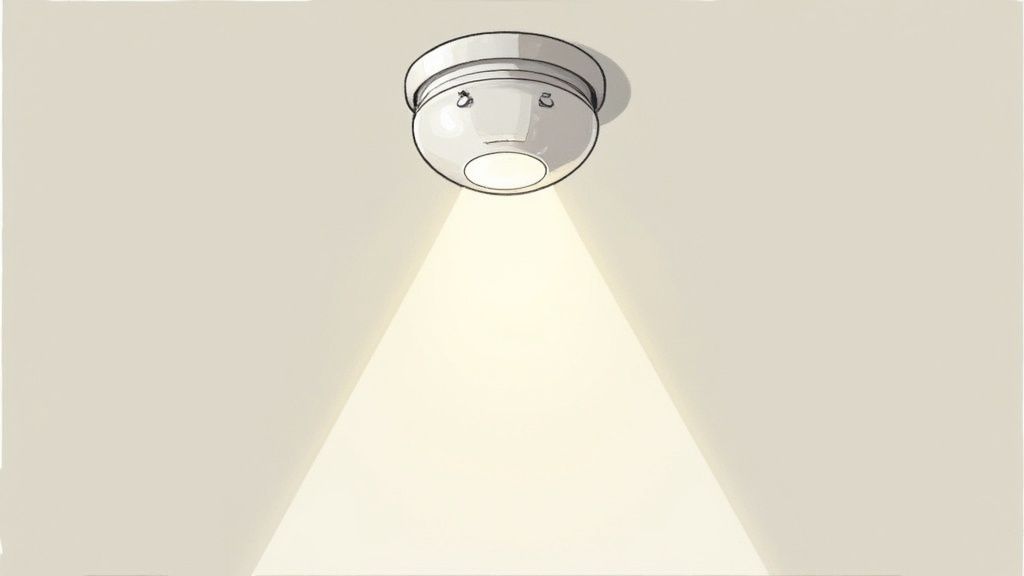
Why Controls Are a Smart Energy Efficiency Solution
Case studies show lighting energy reductions between 40-50% after retrofitting sensors. For facilities in the GCC aiming for certifications like LEED, integrating occupancy and daylight sensors is a critical step, contributing to significant energy reduction credits.
Key Benefit: Advanced controls can slash lighting energy consumption by 30-60% by automatically turning lights off or dimming them in unoccupied areas or when sufficient daylight is available.
Practical Implementation in the GCC
Effective deployment depends on selecting the right technology.
- Select the Right Sensor: Use Passive Infrared (PIR) for enclosed spaces like offices. Use ultrasonic or dual-tech for areas with obstructions like restrooms.
- Position for Accuracy: Install sensors away from HVAC vents or doorways that could cause false triggers.
- Set Appropriate Time Delays: Use a short delay (5-10 min) for low-traffic areas and a longer delay (15-20 min) for busy offices.
- Integrate with Daylight Harvesting: In spaces with large windows, common in Abu Dhabi and Dubai, pair sensors with daylight harvesting to dim artificial lights when natural light is sufficient.
9. Advanced Energy Metering
You can't manage what you don't measure. Advanced energy meters are fundamental to any serious energy management solution Dubai and the wider GCC implement. Moving beyond basic utility meters, these devices provide granular, real-time data on consumption patterns for specific circuits, machines, or zones.
This data is crucial for identifying energy waste, verifying the savings from other upgrades, and enabling predictive maintenance. For panel builders and electricians, integrating smart energy meters into sub-main distribution boards (SMDBs) provides facility managers with the actionable insights needed to drive efficiency.
Why Advanced Metering is a Foundational Solution
An energy meter GCC-based facilities use can pinpoint inefficient equipment or abnormal consumption spikes instantly. This data empowers facility managers to make informed decisions, justify capital expenditures for upgrades, and track ROI accurately.
Key Benefit: Advanced energy meters provide the critical data needed to identify inefficiencies, track performance, and validate the effectiveness of all other energy-saving initiatives, forming the backbone of a successful strategy.
Practical Implementation in the GCC
- Sub-meter Critical Loads: Install dedicated meters on high-consumption assets like HVAC chillers, large motors, and process lines.
- Choose Networked Meters: Select meters that can integrate with a BEMS or other central monitoring platform for automated data collection and analysis.
- Ensure Compliance: Use meters that comply with local utility regulations and standards (e.g., DEWA, SEWA) to ensure data accuracy and acceptance.
- Leverage Data Analytics: Don't just collect data—use it. Set up alerts for abnormal usage and generate regular reports to track progress towards efficiency goals.
Conclusion: Implementing Your Energy Efficiency Strategy
The journey towards operational excellence in the UAE is linked to the intelligent adoption of energy efficiency solutions. It is built upon a strategic integration of diverse technologies, each addressing a specific inefficiency. A proactive, component-level approach yields substantial, facility-wide benefits.
Your Actionable Path Forward
For facility managers, electrical contractors, and system integrators, mastering these concepts is no longer optional. The value extends beyond cost reduction to improved equipment lifespan, enhanced operational reliability, and compliance with regional sustainability mandates.
- Conduct an Energy Audit: Begin with a detailed assessment using energy meters to identify high-consumption areas and establish a baseline.
- Prioritise High-Impact Solutions: Start with "low-hanging fruit" like upgrading to LED lighting or installing occupancy sensors for a quick payback.
- Develop a Phased Plan: Create a multi-stage plan aligned with your budget. Focus on critical systems like HVAC and large motor-driven applications first.
- Partner with a Knowledgeable Supplier: Collaborating with a supplier like GoSwitchgear ensures you select the right components for the demanding UAE climate and your specific application needs.
Ready to transform your facility's energy profile in Dubai or Abu Dhabi? Explore a comprehensive selection of certified GoSwitchgear components, from advanced energy meters to high-efficiency motor starters. Reach out to our Dubai team for project support. Visit GoSwitchgear to find the right solutions and empower your next project.


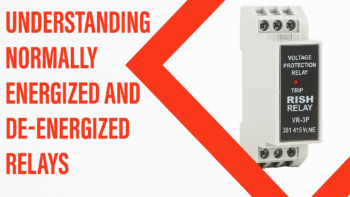
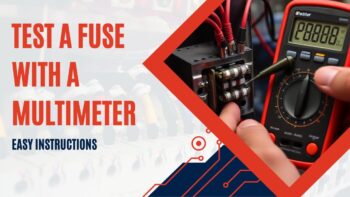

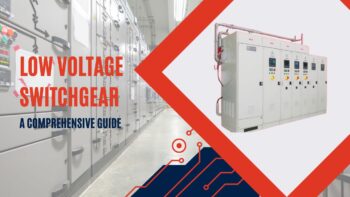

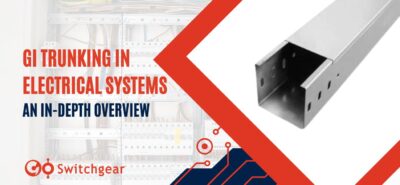

Leave a Reply